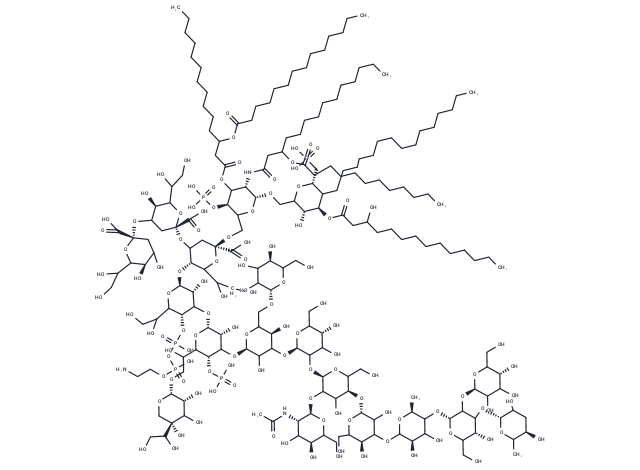Shopping Cart
- Remove All
 Your shopping cart is currently empty
Your shopping cart is currently empty


| Pack Size | Price | Availability | Quantity |
|---|---|---|---|
| 1 mg | $45 | In Stock | |
| 5 mg | $107 | In Stock | |
| 10 mg | $178 | In Stock | |
| 25 mg | $397 | In Stock | |
| 50 mg | $672 | In Stock |
| Description | Lipopolysaccharides (LPS) derived from Escherichia coli 055:B5, are a unique component of the cell wall of Gram-negative bacteria. They are composed of three regions: lipid A, oligosaccharide core, and O-specific polysaccharide (O-antigen). Lipopolysaccharides help maintain the integrity of the cell outer membrane and protect bacteria from damage by bile salts and lipid antibiotics. Lipopolysaccharides are highly immunogenic antigens that can enhance immune responses and can be used to construct inflammatory models. |
| In vitro | METHODS: Human lung mucoepidermoid carcinoma cells H292 and monocytes THP-1 were treated with Lipopolysaccharides (1-20 µg/mL) for 6-48 h. Cytotoxicity was detected by MTT.
RESULTS: No significant changes in the viability of H292 cells treated with 1 and 2.5 µg/mL Lipopolysaccharides and THP-1 cells treated with 1 and 2 µg/mL Lipopolysaccharides were observed. Lipopolysaccharides at higher concentrations (5-20 µg/mL) were significantly cytotoxic to both H292 and THP-1 cells. [1] METHODS: Human induced pluripotent stem cell-derived cardiomyocytes hiPSC-CMs were treated with Lipopolysaccharides (0.1-100 µg/mL) for 6-48 h. Inflammatory cytokine expression was detected by qRT-PCR. RESULTS: The mRNA expression level of IL-1β was increased at 6 h of Lipopolysaccharides treatment, IL-10 was increased only at 48 h, and TNF-α and IL-6 were increased at both 6 and 48 h. [2] METHODS: Neutrophils were treated with Lipopolysaccharides (10 mg/ml) for 4 h. The expression levels of target proteins were measured by Western Blot. RESULTS: The expression of H3-cit and TLR4 increased after treatment with Lipopolysaccharides, which induced the formation of neutrophil extracellular traps (NETs) in neutrophils. [3] |
| In vivo | METHODS: To construct a mouse model of sepsis, Lipopolysaccharides (25 mg/kg) were administered to C57/BL mice by a single intraperitoneal injection.
RESULTS: Lipopolysaccharides induced significant up-regulation of inflammatory factors TNF-α and IL-1β. Lipopolysaccharides induced sepsis in a mouse model. [4] METHODS: To investigate the effects of Lipopolysaccharides on cognitive deficits and neuroinflammation, Lipopolysaccharides (500-750 μg/kg in saline) were injected intraperitoneally into C57BL/6J mice once daily for seven days. RESULTS: Lipopolysaccharides treatment resulted in disease behavior and cognitive deficits in mice, and these effects were accompanied by microglia activation and neuronal cell loss in the hippocampus. Lipopolysaccharides treatment decreased serum and brain homogenate levels of IL-4 and IL-10, and increased levels of TNF-α, IL-1β, PGE2, and NO levels were increased. [5] |
| Alias | LPS |
| Molecular Weight | 4899.92 |
| Formula | C205H366N3O117P5 |
| Storage | Powder: -20°C for 3 years | In solvent: -80°C for 1 year | Shipping with blue ice. |
| Solubility Information | H2O: 5 mg/mL (Need ultrasonic) |

Copyright © 2015-2024 TargetMol Chemicals Inc. All Rights Reserved.